oil YAMAHA WR 450F 2007 Notices Demploi (in French)
[x] Cancel search | Manufacturer: YAMAHA, Model Year: 2007, Model line: WR 450F, Model: YAMAHA WR 450F 2007Pages: 794, PDF Size: 21.82 MB
Page 710 of 794

–+ELEC
6 - 16
CHARGING SYSTEM
EC680000
CHARGING SYSTEM
EC681001
INSPECTION STEPS
If the battery is not charged, use the following inspection steps.
*1 marked: Refer to “FUSE INSPECTION” section in the CHAPTER 3.
*2 marked: Refer to “BATTERY INSPECTION AND CHARGING” section in the CHAPTER 3.
NOTE:
•Remove the following parts before inspection.
1) Seat
2) Fuel tank
•Use the following special tool in this inspection.
Pocket tester:
YU-3112-C/90890-03112
*1 Check fuse.Replace fuse and
check wire harness.
*2 Check battery. Recharge or replace.
Check each coupler and
wire connection.Repair or replace.
Check charging voltage.Charging system is
good.
Check AC magneto. Charging coil Replace.
Replace rectifier/regulator.
OK
OK
OK
No good
OK
No good
No good No good
No good OK
Page 714 of 794
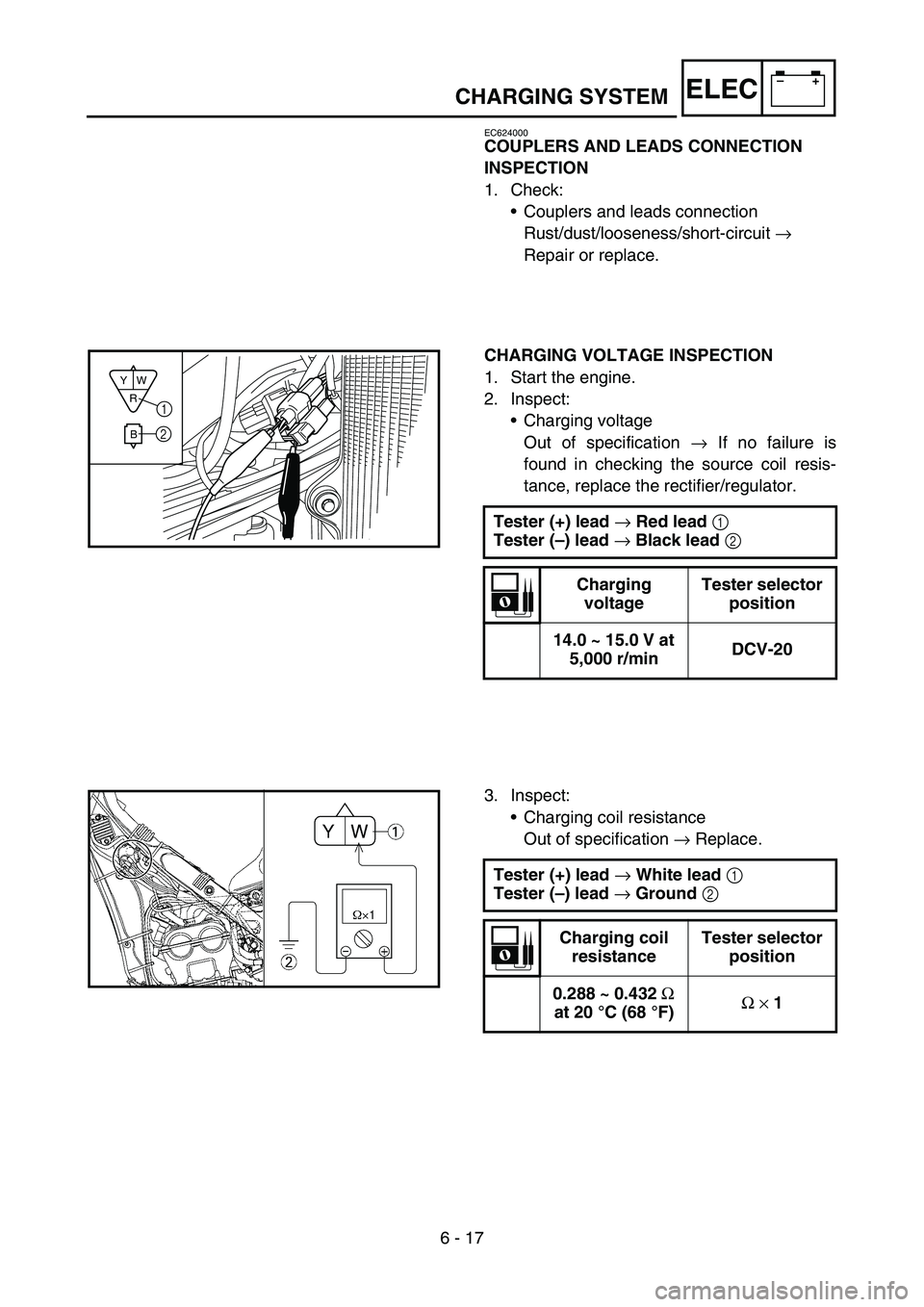
6 - 17
–+ELECCHARGING SYSTEM
EC624000
COUPLERS AND LEADS CONNECTION
INSPECTION
1. Check:
•Couplers and leads connection
Rust/dust/looseness/short-circuit →
Repair or replace.
CHARGING VOLTAGE INSPECTION
1. Start the engine.
2. Inspect:
•Charging voltage
Out of specification → If no failure is
found in checking the source coil resis-
tance, replace the rectifier/regulator.
Tester (+) lead
→ Red lead
1
Tester (–) lead
→ Black lead
2
Charging
voltageTester selector
position
14.0 ~ 15.0 V at
5,000 r/minDCV-20
R
BW Y1
2
3. Inspect:
•Charging coil resistance
Out of specification → Replace.
Tester (+) lead
→ White lead
1
Tester (–) lead
→ Ground
2
Charging coil
resistanceTester selector
position
0.288 ~ 0.432
Ω
at 20 °C (68 °F)Ω
× 1
Page 716 of 794

–+ELEC
6 - 18
TPS (THROTTLE POSITION SENSOR) SYSTEM
EC690000
TPS (THROTTLE POSITION SENSOR) SYSTEM
INSPECTION STEPS
If the TPS will not operate, use the following inspection steps.
NOTE:
Use the following special tools in this inspection.
Pocket tester:
YU-3112-C/90890-03112
Check entire ignition
system for connection.Repair or replace.
Check TPS. TPS coil Replace.
Check CDI unit.TPS input
voltageReplace.
OK
OK
No good
No good
No good
Page 720 of 794

6 - 19
–+ELECTPS (THROTTLE POSITION SENSOR) SYSTEM
HANDLING NOTE
CAUTION:
Do not loosen the screw {TPS (throttle
position sensor)}
1 except when changing
the TPS (throttle position sensor) due to
failure because it will cause a drop in
engine performance.
1
EC624000
COUPLERS AND LEADS CONNECTION
INSPECTION
1. Check:
•Couplers and leads connection
Rust/dust/looseness/short-circuit →
Repair or replace.
TPS COIL INSPECTION
1. Inspect:
•TPS coil resistance
Out of specification → Replace.
2. Loosen:
•Throttle stop screw 1
NOTE:
Turn out the throttle stop screw until the throt-
tle shaft is in the full close position.Tester (+) lead
→ Blue lead
1
Tester (–) lead
→ Black lead
2
TPS coil
resistanceTester selector
position
4 ~ 6 kΩ at
20 °C (68 °F)kΩ × 1
Page 722 of 794

6 - 20
–+ELECTPS (THROTTLE POSITION SENSOR) SYSTEM
3. Inspect:
•TPS coil variable resistance
Check that the resistance in increased as
the throttle grip is moved from the full
close position to the full open position.
Out of specification → Replace.
Tester (+) lead
→ Yellow lead
1
Tester (–) lead
→ Black lead
2
TPS coil variable
resistanceTester selec-
tor position
Full closed Full opened
k
Ω
× 1 0 ~ 2 k
Ω
at 20 °C
(68°F)4 ~ 6 k
Ω
at 20 °C
(68°F)
TPS REPLACEMENT AND ADJUSTMENT
1. Remove:
•TPS coupler
•Carburetor
2. Remove:
•Screw (TPS) 1
•TPS 2
NOTE:
Loosen the screw (TPS) using the T25 bit.
3. Replace:
•TPS
4. Install:
•TPS 1
•Screw (TPS) 2
NOTE:
•Align the slot a in the TPS with the projec-
tion b on the carburetor.
•Temporarily tighten the screw (TPS).
5. Install:
•Carburetor
•TPS coupler
2
1
b
a
2 1
Page 728 of 794
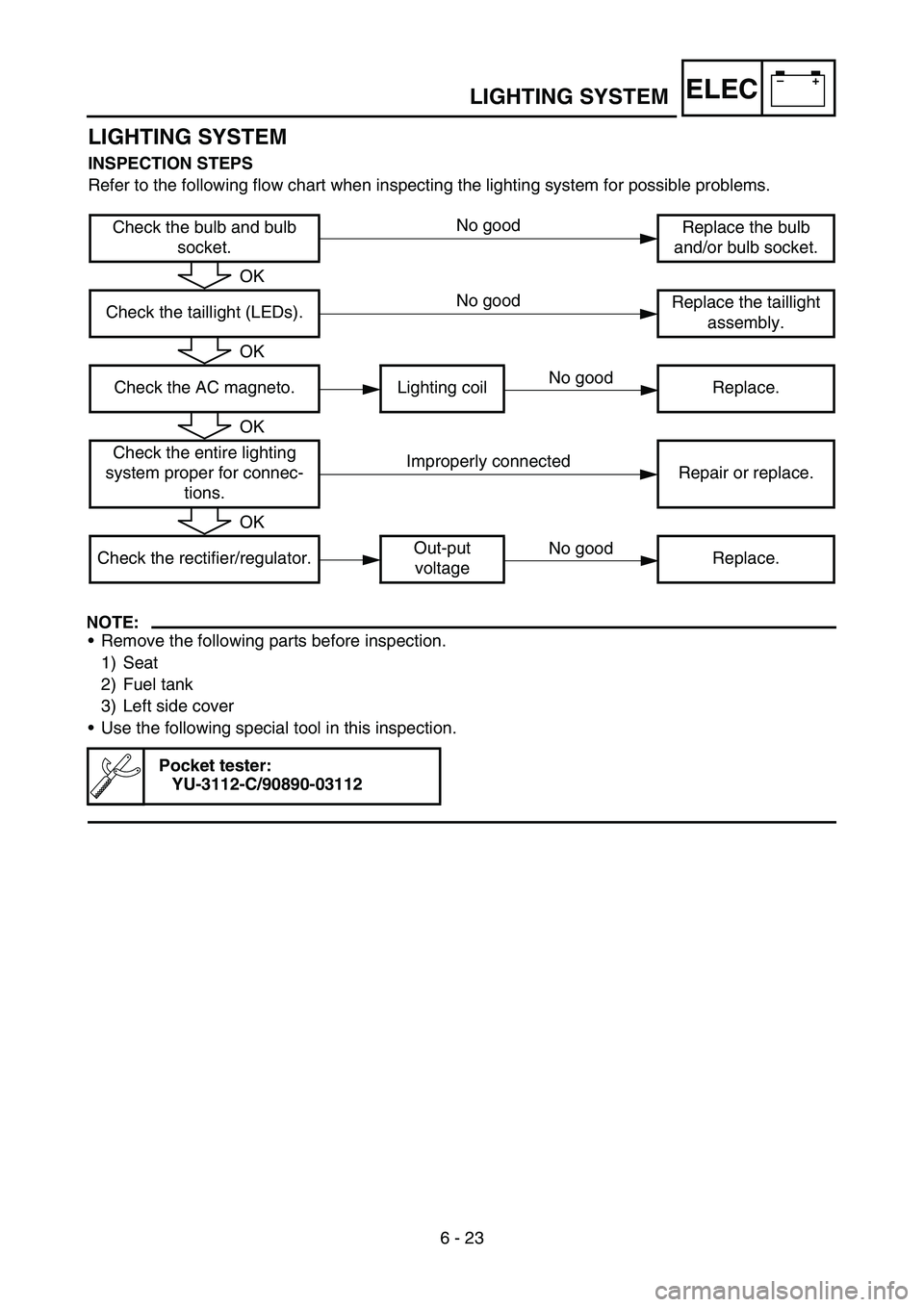
–+ELEC
6 - 23
LIGHTING SYSTEM
LIGHTING SYSTEM
INSPECTION STEPS
Refer to the following flow chart when inspecting the lighting system for possible problems.
NOTE:
•Remove the following parts before inspection.
1) Seat
2) Fuel tank
3) Left side cover
•Use the following special tool in this inspection.
Check the bulb and bulb
socket.Replace the bulb
and/or bulb socket.
Check the taillight (LEDs).Replace the taillight
assembly.
Check the AC magneto. Lighting coil Replace.
Check the entire lighting
system proper for connec-
tions.Repair or replace.
Check the rectifier/regulator.Out-put
voltageReplace.
Pocket tester:
YU-3112-C/90890-03112
No good
OK
No good
OK
No good
OK
Improperly connected
OK
No good
Page 732 of 794
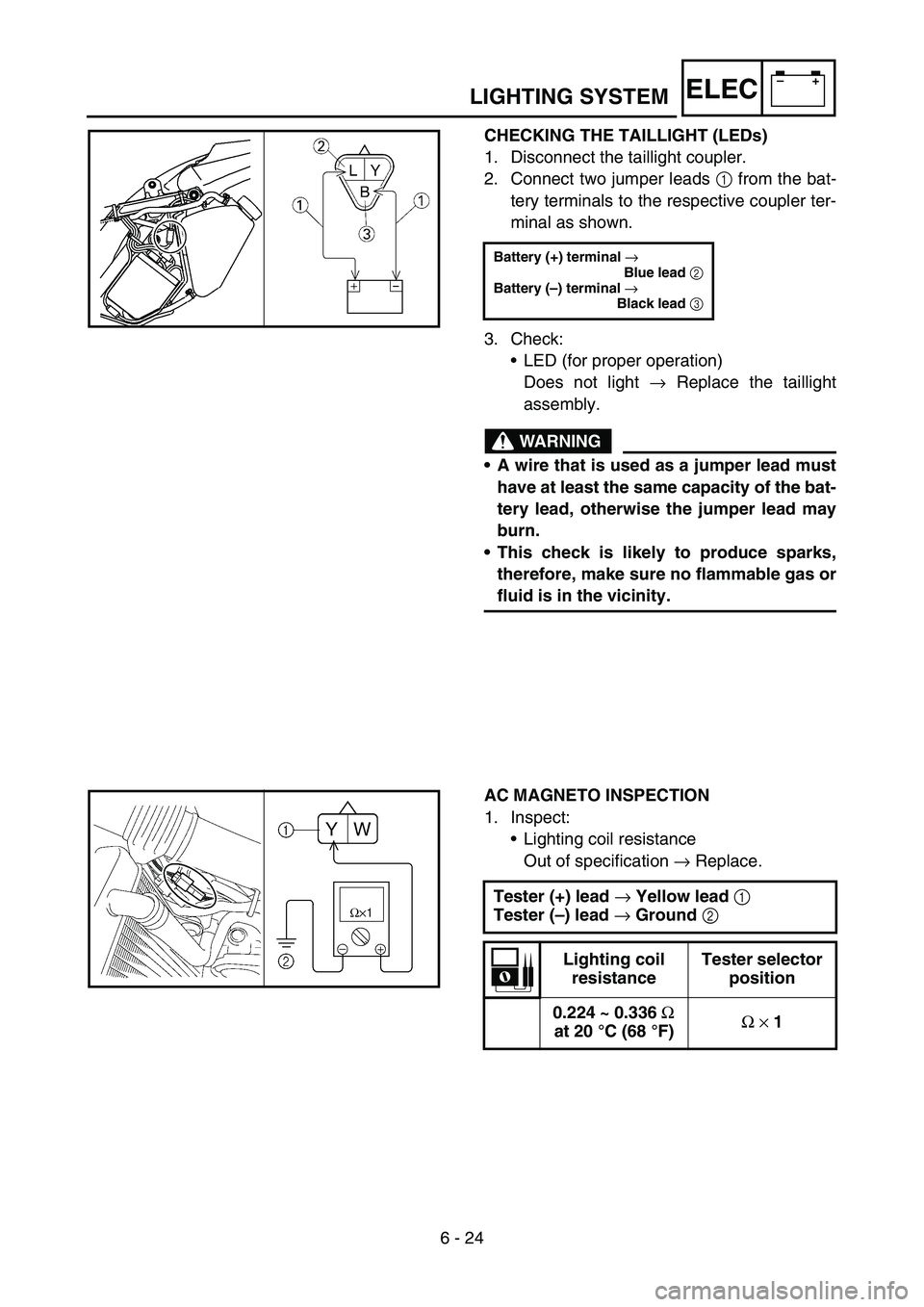
6 - 24
–+ELECLIGHTING SYSTEM
CHECKING THE TAILLIGHT (LEDs)
1. Disconnect the taillight coupler.
2. Connect two jumper leads 1 from the bat-
tery terminals to the respective coupler ter-
minal as shown.
3. Check:
•LED (for proper operation)
Does not light → Replace the taillight
assembly.
WARNING
A wire that is used as a jumper lead must
have at least the same capacity of the bat-
tery lead, otherwise the jumper lead may
burn.
This check is likely to produce sparks,
therefore, make sure no flammable gas or
fluid is in the vicinity.
Battery (+) terminal →
Blue lead
2
Battery (–) terminal →
Black lead
3
AC MAGNETO INSPECTION
1. Inspect:
•Lighting coil resistance
Out of specification → Replace.
Tester (+) lead
→ Yellow lead
1
Tester (–) lead
→ Ground
2
Lighting coil
resistanceTester selector
position
0.224 ~ 0.336
Ω
at 20 °C (68 °F)Ω
× 1
Page 768 of 794
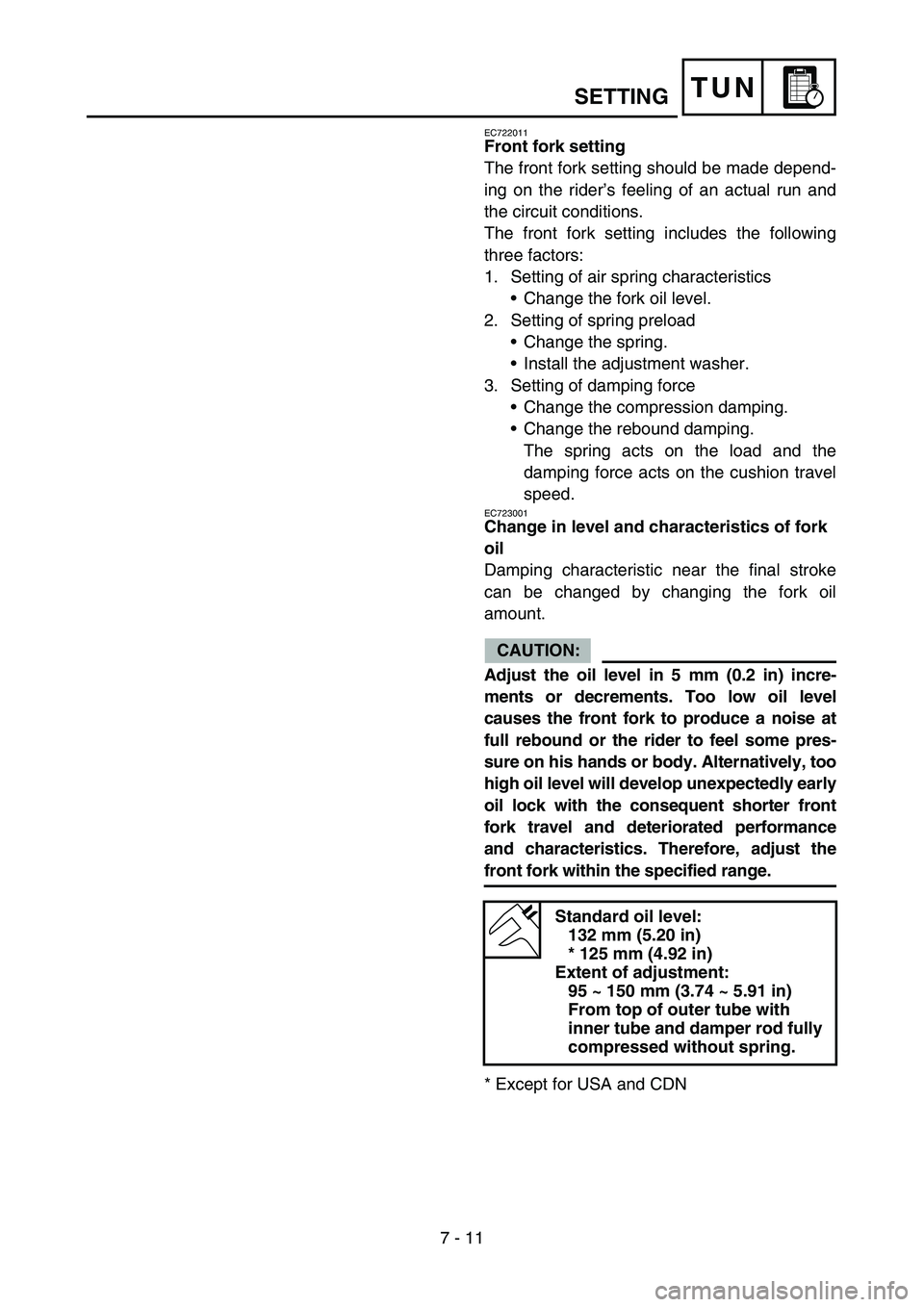
7 - 11
TUNSETTING
EC722011
Front fork setting
The front fork setting should be made depend-
ing on the rider’s feeling of an actual run and
the circuit conditions.
The front fork setting includes the following
three factors:
1. Setting of air spring characteristics
•Change the fork oil level.
2. Setting of spring preload
•Change the spring.
•Install the adjustment washer.
3. Setting of damping force
•Change the compression damping.
•Change the rebound damping.
The spring acts on the load and the
damping force acts on the cushion travel
speed.
EC723001
Change in level and characteristics of fork
oil
Damping characteristic near the final stroke
can be changed by changing the fork oil
amount.
CAUTION:
Adjust the oil level in 5 mm (0.2 in) incre-
ments or decrements. Too low oil level
causes the front fork to produce a noise at
full rebound or the rider to feel some pres-
sure on his hands or body. Alternatively, too
high oil level will develop unexpectedly early
oil lock with the consequent shorter front
fork travel and deteriorated performance
and characteristics. Therefore, adjust the
front fork within the specified range.
* Except for USA and CDN
Standard oil level:
132 mm (5.20 in)
* 125 mm (4.92 in)
Extent of adjustment:
95 ~ 150 mm (3.74 ~ 5.91 in)
From top of outer tube with
inner tube and damper rod fully
compressed without spring.
Page 770 of 794
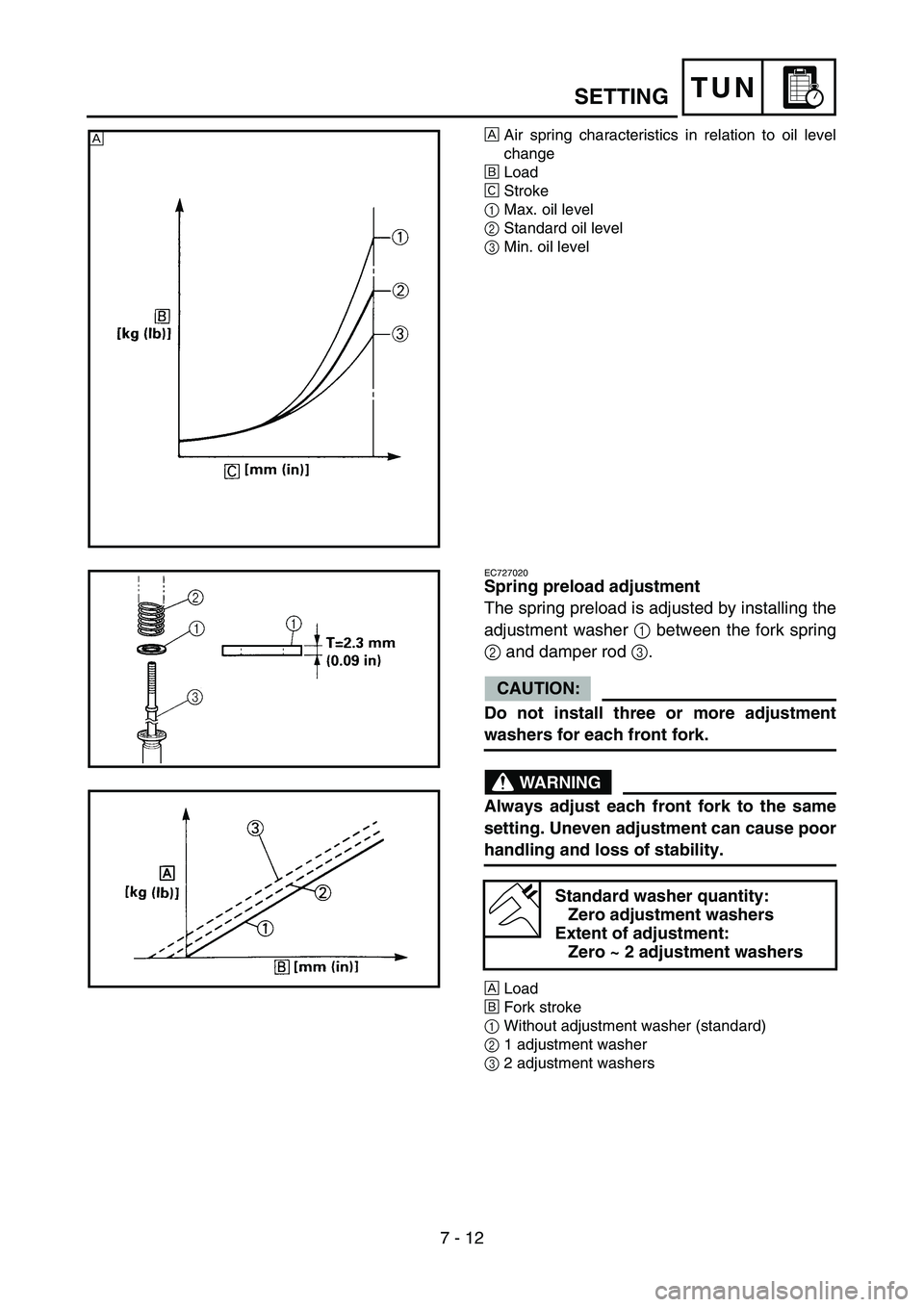
7 - 12
TUNSETTING
ÈAir spring characteristics in relation to oil level
change
ÉLoad
ÊStroke
1Max. oil level
2Standard oil level
3Min. oil levelÈ
EC727020
Spring preload adjustment
The spring preload is adjusted by installing the
adjustment washer 1
between the fork spring
2
and damper rod 3
.
CAUTION:
Do not install three or more adjustment
washers for each front fork.
WARNING
Always adjust each front fork to the same
setting. Uneven adjustment can cause poor
handling and loss of stability.
ÈLoad
ÉFork stroke
1Without adjustment washer (standard)
21 adjustment washer
32 adjustment washers
Standard washer quantity:
Zero adjustment washers
Extent of adjustment:
Zero ~ 2 adjustment washers
Page 784 of 794

7 - 19
TUNSETTING
EC72H002
Suspension setting
•Front fork
NOTE:
•If any of the following symptoms is experienced with the standard position as the base, make
resetting by reference to the adjustment procedure given in the same chart.
•Before any change, set the rear shock absorber sunken length to the standard figure 90 ~ 100 mm
(3.5 ~ 3.9 in).
SymptomSection
Check Adjust
JumpLarge
gapMedium
gapSmall
gap
Stiff over entire rangeCompression damping Turn adjuster counterclockwise (about 2 clicks) to
decrease damping.
Oil level (oil amount) Decrease oil level by about 5 ~ 10 mm (0.2 ~ 0.4 in).
Spring Replace with soft spring.
Unsmooth movement
over entire rangeOuter tube
Check for any bends, dents, and other noticeable
scars, etc. If any, replace affected parts.
Inner tube
Under bracket tightening
torqueRetighten to specified torque.
Poor initial
movementRebound damping Turn adjuster counterclockwise (about 2 clicks) to
decrease damping.
Oil seal Apply grease in oil seal wall.
Soft over entire
range, bottoming outCompression damping Turn adjuster clockwise (about 2 clicks) to increase
damping.
Oil level (oil amount) Increase oil level by about 5 ~ 10 mm (0.2 ~ 0.4 in).
Spring Replace with stiff spring.
Stiff toward stroke
endOil level (oil amount) Decrease oil level by about 5 mm (0.2 in).
Soft toward stroke
end, bottoming outOil level (oil amount) Increase oil level by about 5 mm (0.2 in).
Stiff initial movement Compression dampingTurn adjuster counterclockwise (about 2 clicks) to
decrease damping.
Low front, tending to
lower front postureCompression damping Turn adjuster clockwise (about 2 clicks) to increase
damping.
Rebound damping Turn adjuster counterclockwise (about 2 clicks) to
decrease damping.
Balance with rear end Set sunken length for 95 ~ 100 mm (3.7 ~ 3.9 in)
when one passenger is astride seat (lower rear pos-
ture).
Oil level (oil amount) Increase oil level by about 5 mm (0.2 in).
“Obtrusive” front,
tending to upper front
postureCompression damping Turn adjuster counterclockwise (about 2 clicks) to
decrease damping.
Balance with rear end Set sunken length for 90 ~ 95 mm (3.5 ~ 3.7 in)
when one passenger is astride seat (upper rear pos-
ture).
Spring Replace with soft spring.
Oil lever (oil amount) Decrease oil level by about 5 ~ 10 mm (0.2 ~ 0.4 in).